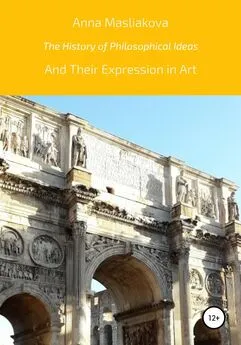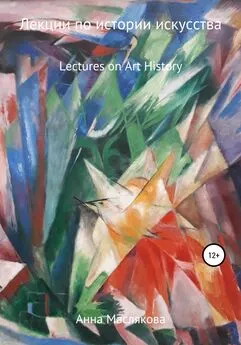Анна Маслякова - The History of Philosophical Ideas and Their Expression in Art
- Название:The History of Philosophical Ideas and Their Expression in Art
- Автор:
- Жанр:
- Издательство:неизвестно
- Год:2020
- ISBN:978-5-532-04940-6
- Рейтинг:
- Избранное:Добавить в избранное
-
Отзывы:
-
Ваша оценка:
Анна Маслякова - The History of Philosophical Ideas and Their Expression in Art краткое содержание
The History of Philosophical Ideas and Their Expression in Art - читать онлайн бесплатно ознакомительный отрывок
Интервал:
Закладка:
Moreover, Plato writes dialogs, tells stories, while Aristotle is more like an objective scientist analyzing and systematizing facts. As we have mentioned before, Plato thought that certain knowledge is innate. Aristotle, on the contrary, says that thinking processes correlate with the nature of reality and mind contributes to knowledge since it brings a capacity to organize, to structure nature and get the unchanging truth of it. For example, in “Metaphysics” he says that “the white is musical and the latter is white, only because both are accidental to man. But Socrates is musical, not in this sense, that both terms are accidental to something else. Since then some predicates are accidental in this and some in that sense, those which are accidental in the latter sense, in which white is accidental to Socrates, cannot form an infinite series in the upward direction; e.g. Socrates the white has not yet another accident; for no unity can be got out of such a sum. Nor again will ‘white’ have another term accidental to it, e.g. ‘musical’. For this is no more accidental to that than that is to this; and at the same time we have drawn the distinction that while some predicates are accidental in this sense, others are so in the sense in which ‘musical’ is accidental to Socrates; and the accident is an accident of an accident not in cases of the latter kind, but only in cases of the other kind, so that not all terms will be accidental”.
To sum it up, we have mentioned several conceptions introduced by Ancient Philosophers. And yet, the question – “Whether or not this Quest for Certainty is ever going to be satisfied?” – remains open.
Dialog of Arts I
The Greco-Roman civilization extended from the glorious Age of Pericles when Greek Culture reached its height, witnessed the expansion of Greek settlements under Alexander the Great, saw the Rise of Roman Power and the grandeur of the Roman Empire and concluded with its decline and fall in 476.
Greek and Roman traditions are completely different, suffice it to mention the Venus of Tauris and Roman Portrait Sculpture executed in realistic manner. The Greeks with their city-states, meetings at Agora, philosophical discussions at the Platonic Academy and Classical Orders have been considered as an example to be followed. The Romans adopted their ideas (for instance, they used to gather at the Forum located at the intersection of the two main roads – Cardo and Decumanus), and yet, they were more interested in technical developments and built a lot of roads and aqueducts bringing water into cities and towns (Devil’s Bridge at Tarragona). Eugène Viollet-le-Duc in his “Lectures on Architecture” says that “The genius of the Roman people differs materially from that of the Greeks. The Roman is essentially an administrator and a politician; he is the founder of the Modern Civilization: but is he, like the Greek, an Artist? Certainly not”. The Romans erected temples on artificial hills made of concrete, whereas the Greeks were fond of Nature and tried to find special places for their structures (the Temple of Segesta in Sicily). Moreover, columns were no longer used as constructive elements and became purely decorative (the Colosseum). “Greek architecture may be best compared to a man strip of his clothes, the external parts of whose body are but the consequence of his organic structure, of his wants, of the framework of his bones, and the functions of his muscles. The man is so much the more beautiful as all the parts of his body are in harmony with their purpose, and, with nothing superfluous, they yet suffice for their functions. Roman architecture, on the other hand, may be compared to a man clothed: there is the man, and there is the dress; the dress may be good or bad, rich or poor in material, well or ill cut, but it forms no part of the body”.
The Greeks and the Romans were not satisfied with white color, on the contrary they used to paint their sculpture and architecture so as to accentuate their Beauty. Viollet-le-Duc writes that “So necessary was this application of color to the exterior of the buildings in a country where the atmosphere is of marvelous transparency, that if we view the Temple of Theseus at Athens (for instance) in full sunshine, now that it has lost its paintings, we shall find it impossible to distinguish the lights of the columns from those shed of the walls of the cellar; – these lights on different planes mingle together and appear as if thrown upon one single surface”.
Life and thought in those days were bound up with the Arts and the Greeks were very well-rounded people. The great Philosophers were men of action who serve Athens at battlefields as well as in public places and Theaters since one of the main responsibilities of a citizen was to foster the Arts. Art in Greece became a generating force by which the Athenians identified themselves with their fellow-citizens and with the entire rhythm of life around them. And through Art human experience has been raised to its highest level. Not only did they use Music in their system of Public Education, but they also incorporated it in their incredible Dramas and Tragedies (let us mention, for example, “Oedipus Rex” by Sophocles – one of the most successful playwrights of the time). Aristotle in his “Poetics” says that “Be that as it may, Tragedy – as also Comedy – was at first mere improvisation. The one originated with the authors of the Dithyramb, the other with those of the phallic songs, which are still in use in many of our cities. Tragedy advanced by slow degrees; each new element that showed itself was in turn developed. Having passed through many changes, it found its natural form, and there it stopped”. “Comedy is, as we have said, an imitation of characters of a lower type, not, however, in the full sense of the word bad, the Ludicrous being merely a subdivision of the ugly. It consists in some defect or ugliness which is not painful or destructive. To take an obvious example, the comic mask is ugly and distorted, but does not imply pain”.
Not only did they believe that Poetry and Music are the same, but they also had the Chorus that often put interesting commentaries on the drama and unified it. Friedrich Nietzsche writes that “If music, as it would seem, was previously known as an Apollonian art, it was, strictly speaking, only as the wave-beat of rhythm, the formative power of which was developed to the representation of Apollonian conditions. The music of Apollo was Doric architectonics in tones, but in merely suggested tones, such as those of the cithara. The very element which forms the essence of Dionysian music (and hence of music in general) is carefully excluded as un-Apollonian; namely, the thrilling power of the tone, the uniform stream of the melos, and the thoroughly incomparable world of harmony”. “According to this view, we must understand Greek tragedy as the Dionysian chorus, which always disburdens itself anew in an Apollonian world of pictures. The choric parts, therefore, with which tragedy is interlaced, are in a manner the mother-womb of the entire so-called dialogue, that is, of the whole stage-world, of the drama proper. In several successive outbursts does this primordial basis of tragedy beam forth the vision of the drama, which is a dream-phenomenon throughout, and, as such, epic in character: on the other hand, however, as objectivation of a Dionysian state, it does not represent the Apollonian redemption in appearance, but, conversely, the dissolution of the individual and his unification with primordial existence. Accordingly, the drama is the Apollonian embodiment of Dionysian perceptions and influences, and is thereby separated from the epic as by an immense gap. The chorus of Greek tragedy, the symbol of the mass of the people moved by Dionysian excitement, is thus fully explained by our conception of it as here set forth” (“The Birth of Tragedy”).
As we have mentioned before, the Romans adopted Greek inventions and developed them on a much larger scale. In Ancient Roman Villas – country houses of nobility rectangular in their shape – they combined Perystilium (a garden surrounded by columns reminding of the Medieval Cloister) and Atrium (the most important part where the guests were greeted) complemented by Compluvium (a square roof opening) and Impluvium (a pool for rainwater). Villas in Pompeii were richly decorated with frescoes of different styles – creating the illusion of marble or panoramic view (like “a window”), emphasizing the flatness of the wall with figures “floating” on it or reintroducing architecture and jumbling together fragments of buildings – and all of them can be seen at the House of Vettii.
And yet, there was a tendency in Roman Philosophy towards individualism and agnosticism (Stoicism, Epicureanism, Skepticism). People were more interested in entertainments, such as Gladiatorial Fights, executions of Christians at the Colosseum and Nero’s singing. It is said that Nero ordered to burn Rome in order to clear the space for his new palace – Domus Aurea designed by Fabulus. It was embellished with gold and decorated with Grotesques which inspired Raphael to create his Loggias in Vatican (and we also have their copies at the Hermitage Museum in Saint Petersburg). After the Emperor’s death the Golden House was filled with earth and built over (Flavian Amphitheater, Baths of Trajan, etc.). By the way, the plan of the Trajan’s Forum reminds of the embracing arms of the Bernini Colonnade, while the structure of Caldarium – a special room with hot water pool at the Roman Baths which had a dome with an opening or oculus – calls to mind the Octagonal Room of the Domus Aurea and the Pantheon. Surprisingly enough, there even was an Ancient Roman Baroque Style, in other words, architects used traditional vocabulary in a different way including too ornate decoration, projections, recessions and broken pediments in their projects (for example, the Market Gate of Miletus in Berlin).
Homer is considered to be the father of Western Civilization and Vergil’s “Aeneid” as an epic traces the general form of “The Iliad” (which tells us about Achilles who managed to overcome his rage and returned Hector’s body to this father Priam) and “The Odyssey” (in which the main hero Odysseus is going back home after the Fall of Troy and experiencing different kinds of hospitality – Cyclopes, Nausicaa, Dionysian Music performed by Sirens, etc.) but in the reverse order. That is to say, the wanderings of Aeneas and his people come first (“Odyssey”) and then the war starts (“Iliad”). J.L. Borges in one of his lectures at Harvard said that “The Geeks had no use for books or no great use for them, it is a fact indeed that most of the great teachers of mankind have been not writers but speakers”. “However, we need not worry too much about the fate of the Classics because Beauty is always with us”. Suffice it to mention the Mysterious smile of Ancient Kore.
Temples of Culture I
The most extraordinary thing about Ancient Greek architecture is their idea about the Sight, that is to say, the organization of space is based on special viewpoints. Here were are in the Theatre of Delphi looking down and all the buildings arrange themselves in such a way as to be viewed obliquely as fully plastic objects.
Basically, the Greek Theater (the Theater at Epidaurus, the Ancient Theater in Tauric Chersonesus, etc.) is an open-air structure composed of a partial circle (Theatron) organized around the Orchestra where action takes place and a backstage (Skene) behind it. And one of the most powerful things is that like in the case of temples – for example, the Temple of Segesta in Sicily – they find a special place that needs to be clarified and make visible its uniqueness that otherwise would be lost.
Читать дальшеИнтервал:
Закладка:









